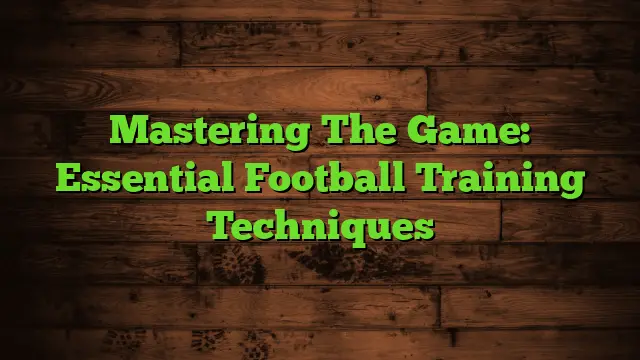Unlocking your full potential on the football field requires dedication, strategy, and the right training techniques. This comprehensive guide will delve into the world of football training, covering everything from fundamental drills to advanced strategies. We’ll explore different training methods, highlight their benefits and drawbacks, and provide practical tips to help you improve your skills, whether you’re a beginner or a seasoned pro. You’ll learn about strength and conditioning, agility training, tactical awareness, and much more. Get ready to elevate your game!
Effective football training isn’t just about running drills; it’s a holistic approach focusing on physical fitness, technical skills, tactical understanding, and mental fortitude. This section lays the groundwork, defining what constitutes effective football training and its importance in player development.
- Physical Conditioning: Strength training, speed and agility drills, cardiovascular fitness.
- Technical Skills: Passing,
shooting, dribbling, tackling, heading.
- Tactical Awareness: Positioning, game reading, strategic decision-making.
- Mental Strength: Focus, resilience, composure under pressure.
Strength and Conditioning for Football
Building a strong and resilient physique is paramount in football. This section explores various strength training methods, emphasizing the importance of proper form and progressive overload to avoid injury and maximize gains. We’ll discuss the use of weightlifting, plyometrics, and bodyweight exercises, highlighting their roles in enhancing performance on the pitch.
Strength Training Programs for Footballers
- Weightlifting: Focus on compound exercises like squats, deadlifts, and bench presses.
- Plyometrics: Box jumps, depth jumps, and medicine ball throws for explosive power.
- Bodyweight Training: Push-ups, pull-ups, and dips for functional strength.
Speed and Agility Training: Enhancing Quickness and Movement
Speed and agility are crucial in football, determining a player’s ability to outpace opponents and react quickly to changing game situations. This section outlines various drills and training methods to enhance speed, agility, and quickness. We will look at ladder drills, cone drills, and sprint training.
Drills to Improve Speed and Agility
- Ladder Drills: Improve footwork and coordination.
- Cone Drills: Enhance agility and change of direction.
- Sprint Training: Develop top-end speed and acceleration.
Technical Skills Training: Mastering the Fundamentals
Technical skills form the foundation of a footballer’s abilities. This section breaks down the key technical skills – passing, shooting, dribbling, tackling, and heading – providing detailed explanations, drills, and practical tips for improvement.
Drills for Each Technical Skill
- Passing: Accuracy, distance, weight of pass.
- Shooting: Power, accuracy, technique.
- Dribbling: Ball control, speed, agility.
- Tackling: Timing, technique, positioning.
- Heading: Technique, power, accuracy.
Tactical Awareness and Game Intelligence
Understanding the game’s dynamics and anticipating opponents’ moves is as critical as physical prowess. This section discusses tactical awareness, focusing on positioning, reading the game, and making strategic decisions on the field. We’ll examine different formations and their strengths and weaknesses.
Developing Tactical Awareness
- Game Analysis: Watch professional matches to learn from experts.
- Positional Play: Understand the roles and responsibilities of different positions.
- Strategic Thinking: Anticipate opponents’ moves and make informed decisions.
Mental Toughness and Focus
Football demands mental resilience. This section will explore techniques to cultivate mental strength, focus, and composure under pressure. We’ll look at mindfulness, visualization, and positive self-talk.
Building Mental Fortitude
- Mindfulness: Improve focus and concentration.
- Visualization: Mentally rehearse successful plays.
- Positive Self-Talk: Build confidence and maintain a positive mindset.
Nutrition and Recovery for Footballers
Proper nutrition and recovery are crucial for optimal performance and injury prevention. This section outlines nutritional guidelines for footballers and recovery strategies to accelerate muscle repair and reduce fatigue.
Optimal Nutrition and Recovery Strategies
- Hydration: Drink plenty of water throughout the day.
- Carbohydrate Intake: Fuel your workouts with complex carbohydrates.
- Protein Intake: Build and repair muscles with adequate protein.
- Sleep: Aim for 7-9 hours of quality sleep per night.
Injury Prevention and Rehabilitation
Avoiding injuries is essential for sustained performance. This section details techniques for injury prevention and effective rehabilitation strategies should injuries occur.
Preventing and Recovering from Injuries
- Warm-up Properly: Prepare your body for physical activity.
- Cool-down Properly: Allow your body to gradually return to rest.
- Proper Stretching: Improve flexibility and range of motion.
- Listen to your body: Rest when needed.
Teamwork and Communication on the Field
Football is a team sport; success hinges on effective teamwork and communication. This section explores techniques for improving teamwork and communication both on and off the field.
Improving Teamwork and Communication
- Clear Communication: Use verbal and non-verbal cues effectively.
- Trust and Respect: Build strong relationships with teammates.
- Shared Goals: Work towards common objectives.
Individual vs. Team Training: Finding the Right Balance
Balancing individual training with team practice is critical for all-around development. This section explores the benefits of both and how to effectively integrate them into a training schedule.
Individual vs. Team Training Strategies
- Individual Training: Focus on skill development and physical conditioning.
- Team Training: Develop tactical awareness, teamwork, and game strategy.
Advanced Football Training Techniques
For advanced players seeking to refine their skills and reach peak performance, this section discusses specialized training techniques and strategies.
Advanced Training Methods
- Interval Training: High-intensity bursts followed by periods of rest.
- Strength and Conditioning Specialization: Focus on specific muscle groups.
- Advanced Tactical Drills: Simulate game scenarios to refine decision-making.
Utilizing Technology in Football Training
Technology plays an increasing role in football training. This section explores how tools like video analysis, wearable sensors, and training apps can enhance performance.
Technology in Football Training
- Video Analysis: Identify strengths and weaknesses in performance.
- Wearable Sensors: Track key performance indicators.
- Training Apps: Provide personalized training plans and feedback.
Common Mistakes in Football Training
Avoiding common pitfalls can prevent setbacks and injuries. This section outlines frequent mistakes and how to avoid them.
Avoiding Common Training Mistakes
- Overtraining: Allow for adequate rest and recovery.
- Ignoring Proper Warm-up and Cool-down: Prevent injuries and muscle soreness.
- Neglecting Nutrition and Hydration: Fuel your body properly.
The Importance of Rest and Recovery
Rest and recovery are as important as training itself. This section emphasizes the necessity of adequate sleep, nutrition, and active recovery.
Prioritizing Rest and Recovery
- Adequate Sleep: 7-9 hours of quality sleep per night.
- Active Recovery: Light activities like walking or stretching.
- Nutrition: Consume nutrient-rich foods to aid recovery.
Creating a Personalized Football Training Plan
A well-structured training plan is essential for success. This section provides guidance on creating a personalized plan tailored to individual goals and capabilities.
Developing a Personalized Training Plan
- Set Realistic Goals: Define short-term and long-term objectives.
- Assess Your Current Fitness Level: Identify your strengths and weaknesses.
- Create a Training Schedule: Plan workouts, rest days, and recovery periods.
Frequently Asked Questions
What are the most important aspects of football training techniques?
The most crucial aspects are a blend of physical conditioning (strength, speed, agility), mastering technical skills (passing, shooting, dribbling), developing tactical awareness (positioning, reading the game), and building mental resilience (focus, composure under pressure).
How often should I train?
The frequency depends on your level and goals. Beginners might start with 3-4 sessions per week, while advanced players may train more frequently, incorporating rest days for recovery.
What kind of equipment do I need for football training?
Basic equipment includes footballs, cones, hurdles, and possibly weights or resistance bands for strength training. More advanced training might involve GPS tracking devices or video analysis software.
Can I train alone, or do I need a team?
Both individual and team training are important. Individual training allows you to focus on specific skills and fitness, while team training develops tactical awareness and teamwork.
How can I prevent injuries during football training?
Proper warm-up and cool-down routines, appropriate stretching, gradual progression in training intensity, and listening to your body are crucial for injury prevention.
How long does it take to see results from football training?
The timeline varies depending on individual factors, training intensity, and consistency. You can expect to see improvements in fitness and skills over several weeks or months of consistent training.
Final Thoughts
Mastering football training techniques is a journey, not a destination. Consistent effort, a well-structured training plan, and a commitment to continuous improvement will lead to significant advancements in your skills and overall performance on the field. Remember to prioritize proper nutrition, rest, and recovery to avoid burnout and injury. Whether you focus on individual drills or team practices, the key is dedication and a strategic approach to training. By incorporating the techniques and strategies discussed in this comprehensive guide, you’ll be well on your way to unlocking your full potential as a footballer. So, lace up your boots, hit the field, and start your journey to becoming a better player today!





